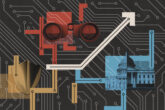April 29, 2025
Five Objectives to Guide U.S. AI Diffusion
Comments on the Framework for AI Diffusion
Summary
The Framework for AI Diffusion (the Framework) is an ambitious proposal to shape the global distribution of critical AI capabilities, maintain U.S. AI leadership, and prevent sensitive technologies from reaching the PRC and other adversaries. We endorse the Framework’s core national security objectives to protect advanced AI capabilities and prevent proliferation that goes against U.S. interests.
The coming years will be critical for determining which country will lead the global AI transformation. The AI Diffusion Rule, despite its risks, could help preserve U.S. leadership at this critical juncture and manage unwanted technology transfer to adversaries. Even short pauses in controls could open the floodgates for chip stockpiling and smuggling. Recognizing that any policy is only as good as its implementation, we urge policymakers to align the design of any revisions to the Framework with the capacity to implement and enforce them.
The Framework’s complexity and broad use of export controls has generated substantial concern among international partners. We therefore recommend that the Trump administration balance restrictive measures designed to protect America's technological edge with developing and promoting American AI offerings internationally to demonstrate the benefits of partnering with the United States.
Regardless of whether the administration chooses to continue or modify the Framework, we urge policymakers to continue to pursue its four core national security objectives, along with a fifth additional objective:
1. Maintain a focus on AI compute as a key enabler of AI leadership.
Compute is critical to AI leadership and remains America’s most defensible advantage. Despite recent advances in algorithmic efficiency, U.S. policymakers should continue to focus on preserving America’s compute lead.
2. Address chip smuggling to China.
Despite U.S. export restrictions, chip smuggling operations are providing the PRC with illegal access to advanced AI chips, eroding the U.S. lead. To fortify the U.S. advantage, Washington needs a better way to enforce controls and prevent smuggling.
3. Prevent competitors from overtaking the U.S. in AI, while still enabling AI diffusion.
As policymakers consider the future of the Framework, we recommend keeping cap-like restrictions on nations with the ability to leapfrog the U.S. lead (i.e. UAE and Saudi Arabia), while ensuring that any changes continue to allow easy diffusion of chips at low quantities, allowing U.S. technology to underpin AI applications globally.
4. Stop adversaries from training frontier models through the cloud.
Keeping AI chips in U.S. or allied data centers is not sufficient to ensure that advanced AI capabilities are protected from adversaries; we therefore recommend retaining the model weight protections that effectively control remote access risks. If the administration winds these protections, we alternatively recommend including know-your-customer protections for frontier levels of compute usage as a licensing condition.
5. Develop and promote U.S. AI offerings internationally.
There is an opportunity to better demonstrate the value of America as an AI partner. We recommend that restrictive measures designed to protect America's technological edge be carefully balanced with proactive initiatives to promote U.S. compute and AI offerings to allies and partners.
Read the Full Response
More from CNAS
-
Technology & National Security
CNAS Insights | The Export Control Loophole Fueling China's Chip ProductionThis week, Reuters reported that China has apparently built a prototype of an extreme ultraviolet lithography (EUV) system, a highly intricate machine used to produce cutting-...
By Michelle Nie, Autumn Dorsey & Janet Egan
-
Energy, Economics & Security / Technology & National Security
Recommendations for Promoting American AI AbroadStrategic Context and Program Objectives The American AI Exports Program is an ambitious and essential proposal to expand the reach of American AI technologies in foreign mar...
By Janet Egan, Geoffrey Gertz, Daniel Remler & Ruby Scanlon
-
Technology & National Security
Prepared, Not ParalyzedExecutive Summary The Trump administration has embraced a pro-innovation approach to artificial intelligence (AI) policy. Its AI Action Plan, released July 2025, underscores t...
By Janet Egan, Spencer Michaels & Caleb Withers
-
Indo-Pacific Security / Energy, Economics & Security / Technology & National Security
Selling AI Chips Won’t Keep China Hooked on U.S. TechnologyU.S. policy should not rest on the illusion that selling chips can trap China inside the American tech ecosystem....
By Janet Egan




